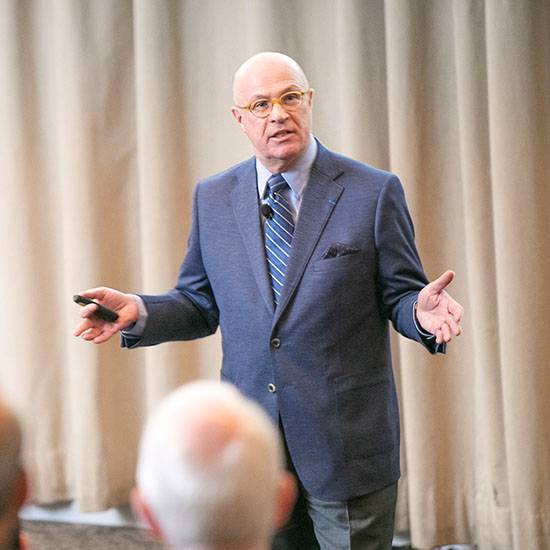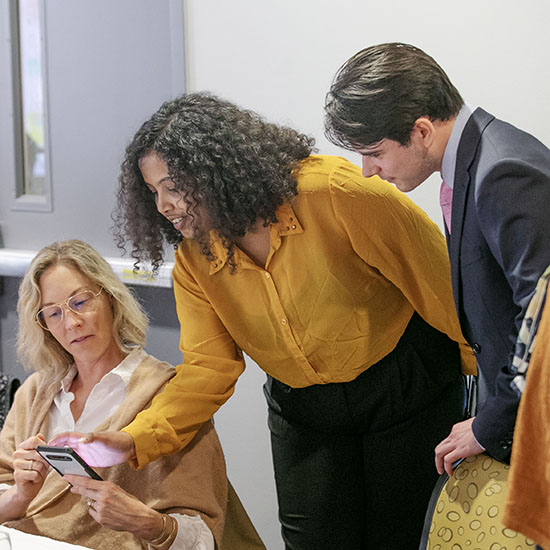Life-changing molecules in the spotlight
Tang exhibit features 10 compounds that changed course of human history
Reprinted with permission from the Sunday Gazette, December 16, 2007
By Karen Bjornland
They are only empty pill bottles, but there are thousands of them, locked together.
Light-catching, glowing towers of orange plastic; a palace of powerful prescription
drugs. Is it a fortress against pain and distress? An amusing monument to Lipitor
and Zoloft?
?It looks like our everyday life,? one senior citizen wryly observed after encountering
the Jean Shin sculpture ?Chemical Balance 2? at the Tang Teaching Museum and Art Gallery.
 Chemistry has certainly changed our lives, and that?s the message of Molecules That Matter, an unusual exhibit that?s stirring up students at Skidmore College and the Capital
Region?s rich community of scientists. Last month, when Cornell University?s Dr. Roald
Hoffman gave a talk, the auditorium at Skidmore overflowed with visitors who came
to hear the 1981 Nobel Laureate in chemistry and see the Tang show.?
Chemistry has certainly changed our lives, and that?s the message of Molecules That Matter, an unusual exhibit that?s stirring up students at Skidmore College and the Capital
Region?s rich community of scientists. Last month, when Cornell University?s Dr. Roald
Hoffman gave a talk, the auditorium at Skidmore overflowed with visitors who came
to hear the 1981 Nobel Laureate in chemistry and see the Tang show.?
Working closely with the Chemical Heritage Foundation and a distinguished panel of
scientists, including Hoffmann, the Tang explores 10 organic molecules that changed
our lives in the 20th century.
Divided by decade
For each decade, there is a dominant molecule, beginning with aspirin in 1900, and
ending in 1990 with buckminsterfullerene, a new form of pure carbon that?s part of
the nanotechnology boom. The other mighty molecules are isooctane (the hydrocarbon
fuel that eliminated engine knocking), penicillin, polyethylene, nylon, DNA, progestin
(the birth control pill), DDT and Prozac.
?These 10 substances have changed our identity. We are different than our grandparents
because of them,? says Ray Giguere, the Skidmore chemistry professor who co-organized
the show with museum director John Weber.
Divided by each decade and its prominent molecule, in each section we learn about
how the substance was discovered and developed, contemplate related artworks and look
at objects and artifacts. There are Bayer aspirin posters from China, pink flamingo
lawn ornaments, a 1929 Chevy engine, Tupperware containers and a bottle once used
to grow penicillin. But the actual molecular world is infinitesimally small. For example,
consider that there are more molecules of water in one teaspoon than there are teaspoons
of water in all the Earth?s oceans. To ?see? the molecules, the Tang fabricated 10
larger-than-life organic chemistry models that look somewhat like giant Tinkertoys,
with colored spheres, the size of softballs and soccer balls, linked together with
metal rods.
?They are scientifically accurate,? says Weber. ?The distances and angles are what
chemists really think about.?
Molecules That Matter follows in the footsteps, yet ventures far beyond, other interdisciplinary Tang shows
that have pulled in ideas from outside the visual arts, including And Therefore I Am, about the brain and thought, which was curated by Weber, and Paradise Now: Picturing the Genetic Revolution and A Very Liquid Heaven, an art/astronomy exhibit.
?It?s a science show that cares a lot about the art in it,? Weber says of Molecules.
?Your life would be different?
Shin?s pill bottle sculpture, which was made for a 2005 show at the University Art
Museum, is installed in the shadow of the molecular model for penicillin, the wonder
drug that has increased average life expectancy by 10 years. Magazine ads and articles
detail the journey from its discovery by Alexander Fleming in 1928 to its mass production
in the 1940s.
?We want to gently tap people on the shoulder,? says Weber, teaching them that ?your
life would be different without these things.?
In the section about progestin and birth control pills, female viewers over age 50
may recognize pill packets, buttons and slogans from the feminist revolution or a
Loretta Lynn album featuring her 1974 hit song ?The Pill.? Artist Chrissy Conant,
single and childless, confronts the motherhood issue by harvesting eggs from her ovaries
and packaging them in a glass jar like expensive caviar.
Potentially controversial subjects ? genetic engineering, protecting the environment,
the wide use of anti-depressants ? bubble up throughout the show, but the Tang aims
to teach not proselytize.
?Our goal is to make people more interested. We?re not trying to tell anyone how
to think,? says Weber.
Around the corner, we learn about nylon, which is six times stronger than steel of
the same weight. In 1940, when DuPont started making nylon stockings, 4 million pairs
were sold in their first four days on the market. In some cities, there were department
store riots by shoppers desperate for the new hosiery.
Giguere interviewed 94-year-old Joseph Labovsky, a chemical engineer and the last
living person to work with Dr. Wallace Carothers, the inventor of nylon and one of
the most brilliant scientists of the 20th century. Visitors can watch a video of Labovsky
talking about Carothers, who killed himself in 1937 by drinking a cocktail of lemon
juice and potassium cyanide.
Familiar names
Disciples of visual art will know many of the 15 artists in the show.
Frank Moore?s painting of a hospital patient floating in a desperate sea, was made
in 2002, not long before he died of AIDS. Moore was also the designer of the red ribbon
logo that symbolizes the fight against AIDS.
?New Figuration,? a 1985 collage crafted from colorful plastic, is the work of British-born
sculptor Tony Cragg, who was recently awarded Japan?s Praemium Imperiale, which is considered the Nobel Prize of art.
New York City artist Fred Tomaselli?s collage created with 13,000 aspirin is here,
and Bryan Crockett, maker of the ?Oncomouse? in the 2000 genetics show, returns to
the Tang with unsettling sculptures from ?Seven Deadly Sins.?
From our region, Michael Oatman offers his 2004 ?Code of Arms,? a DNA-inspired personal
family tree framed with antique test-tube racks, and from Susie Brandt, there?s a
quilt made of nylon pantyhose.
?People in the sciences have come and enjoyed it and looked at art in a way they
wouldn?t before,? Weber says.
For Giguere, who was the catalyst for the exhibit, Molecules That Matters began in 1988, when he developed a course called ?Organic Synthesis and Society?
for students in Skidmore?s interdisciplinary liberal arts program. When the Tang opened
in 2000, professors from every discipline were invited to propose exhibit ideas, and
Giguere came up with the organic chemistry concept.
Since the exhibit opened Sept. 8, students have written more than 400 essays about
it, he says. Sociology students have debated about which substance is the most essential
to human society; female students were shocked to discover that the birth control
pill was once a controversial drug.
And Skidmore students are just the beginning. After closing at the Tang in April,
Molecules That Matter will travel to Philadelphia and christen a new gallery at the Chemical Heritage Foundation.
The show then moves to the College of Wooster in Ohio, Baylor University in Texas
and Grennell College in Iowa.
With a declining interest in chemistry on American campuses and a growing need for
scientists in the workplace, Giguere sees the exhibit as ?a way of hooking young minds
into this stuff.? Studying chemistry requires discipline. It?s like learning a foreign
language, he admits, but more young people need to know about the career opportunities.
?Chemistry is important work,? Giguere says.
2007 the Sunday Gazette


